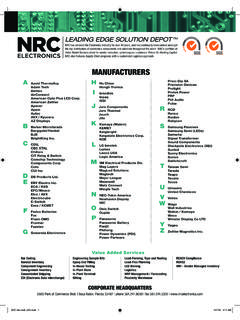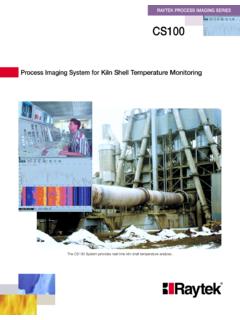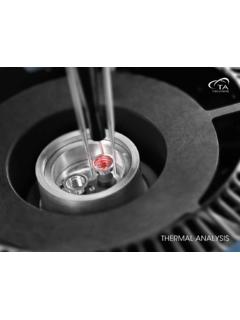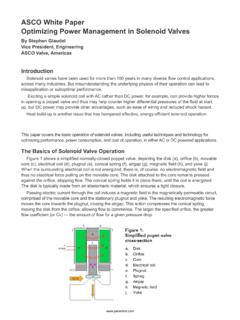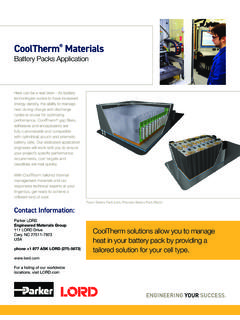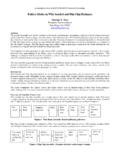Transcription of Li-ion battery-charger solutions for JEITA compliance
1 Analog Applications JournalHigh-Performance Analog Products 1Q 2010 texas instruments Incorporated8Li-ion battery - charger solutions for JEITA complianceIntroductionLithium-ion ( Li-ion ) batteries tend to become dangerous when they are overcharged at high temperatures. Safely charging these batteries has become one of the most important design specifications in battery -powered porta-ble equipment. Progress has been made in establishing industry standards such as the Japan Electronics and Information Technology Industries Association ( JEITA ) guidelines for improving battery -charging safety. This article addresses safety requirements and battery - charger solutions that meet these requirements in both notebook and single-cell handheld safety and the JEITA guidelinesWidely used in consumer electronics from cell phones to laptops, Li-ion batteries have the highest volumetric and gravimetric energy densities among the rechargeable batteries, with no memory effect.
2 They also have a self- discharge rate that is 10 times lower than that of NiMH batteries, and they can provide the instant power required by the system; but are they safe?Everyone in the industry has seen pictures of exploding laptops and heard about the massive and unprecedented recalls of Li-ion batteries due to cell safety concerns. Such battery explosions or fires originated within the manufac-turing process. Batteries contain several metal parts that can sometimes result in undesirable metal impurities within the cell. These impurities are typically sharp metal shards from the battery casing or from electrode materials. If these shards get between the battery s electrode and sepa-rator, battery cycling in the negative electrode can eventu-ally cause the shards to puncture the separator.
3 This results in a microshort between the positive and negative electrodes, producing high heat that may ultimately result in fire and/or an temperatures, fire, and explosions are all results of thermal runaway a condition whereby a battery enters into an uncontrollable reaction. Thermal runaway is a proc ess in which the internal temperature of a battery with LiCoO2 as the cathode material and graphite as the anode material reaches approximately 175 C. This is an irreversible and highly exothermic reaction that can cause a fire, usually when the battery is 1 shows the charge current and charge voltage over temperature commonly used in the older Li-ion - battery -charging systems that are prone to thermal run-away. Both the battery charge current and charge voltage are constant over the cell temperature from 0 to 45 C.
4 High cell temperatures not only speed up battery aging but also increase the risk of battery improve the safety of charging Li-ion batteries, JEITA and the battery Association of Japan released new safety guidelines on April 20, 2007. Their guidelines emphasized the importance of avoiding a high charge current and high charge voltage at certain low and high temperature ranges. According to JEITA , problems in the Li-ion batteries occur at high charge voltages and high cell By Jinrong QianSector Manager, battery Charge Management Advanced PortablePower ManagementChargeCurrentChargeVoltageUppe r-Limit Voltage: V( V Typical)Upper-Limit Charge Current: 1 CTemperatureNo ChargeNo ChargeTI(0 C)T4(40 to45 C)Figure 1. Upper-limit charge current and charge voltage in older Li-ion - battery -charging systemsTexas instruments Incorporated9 Analog Applications Journal1Q 2010 High-Performance Analog Productstemperatures.
5 Figure 2 shows the JEITA guide-lines for the charge current and charge voltage over cell temperature for batteries used in notebook applications. These batteries have LiCoO2 as the cathode active material and graphite as the anode active the standard charging temperature range from T2 to T3, a Li-ion cell can be charged in the optimal conditions of the upper-limited charge voltage and the upper-limited charge current recommended by the cell s manufac-turer for at low temperaturesIf the cell s surface temperature becomes lower than T2 during charging, the lithium ions could each gain one electron and become metallic lith-ium. This metallic lithium is likely to deposit on the anode, because at low temperatures the transfer rate decreases and the penetration of lithium ions into the negative electrode carbon slows down.
6 Such metallic lithium could easily react with electro lyte, causing permanent loss of the lithium ions, which degrades the battery faster. In addition, the chemi-cal reaction between metallic lithium and the electrolyte generates a lot of heat, which could lead to thermal run-away. Therefore, the charge current and charge voltage are reduced at low cell temperatures. If the temperature is further reduced to T1 (0 C as an example), the system should not allow at high temperaturesIf the cell s surface temperature rises above T3 (45 C as an example) dur-ing charging, the cathode material, LiCoO2, starts to become more active and can chemically react with the electrolyte when the cell voltage is high. If the cell temperature is further increased to T4, the system should prohibit charging.
7 If the cell temperature reaches 175 C with a cell voltage of V, thermal runaway may occur and the battery may , Figure 3 shows the JEITA guidelines for charging Li-ion batteries in single-cell handheld applications, where the charge current and charge voltage are also functions of the cell temperature. The maximum charge voltage of V includes the battery charger s full tolerance. The battery can be charged at up to 60 C with a reduced charge voltage for ManagementChargeCurrentChargeVoltageUppe r-Limit Voltage: V( V Typical)Upper-Limit Charge CurrentTemperatureNo VNo ChargeT1T2(10 C)T3(4 5 C)T4 Figure 2. JEITA guidelines for charging Li-ion batteries in notebook applicationsMaximum Charge Voltage: V( V Typical) V MaximumMaximum Charge Current: V MaximumChargeCurrentChargeVoltageTempera tureT2(10 C)T1(0 C)T3(45 C)T4(50 C)T5(60 C)Figure 3.
8 JEITA guidelines for charging Li-ion batteries in single-cell handheld applicationsBattery- charger solutions for meeting JEITA guidelinesThe smart battery pack, which includes a fuel gauge, analog front end, and second-level protector, is commonly used in notebook applications. The fuel gauge provides the battery s cell voltage, charge and discharge current, cell temperature, remaining capacity, and run time to the system through SMBus for optimizing the system perform-ance. The bq20z45 and bq20z40 fuel gauges with Impedance Track technology, recently developed by texas instruments Incorporated10 Analog Applications JournalHigh-Performance Analog Products 1Q 2010 Power ManagementTexas instruments (TI), include a series of flash-memory constants for flexibly programming the battery s charge current and charge voltage based on the JEITA guidelines.
9 The temperature thresholds are user-programmable and provide flexibility for meeting different specifications with different applications. The fuel gauge usually broadcasts the charge current and voltage information to the smart battery charger or keyboard controller for periodically setting the proper charge current and voltage. An SMBus-controlled battery charger , such as the TI bq24745, can be used as a slave device to get the charge voltage and cur-rent information from a smart battery pack with either the bq20z40 or the bq20z45 fuel 4 shows a schematic of a smart battery charger with a smart battery pack that complies with the JEITA guidelines for notebook applications. This SMBus-controlled battery charger with a synchronous switching buck converter can support Li-ion batteries with one to four cells and a charge current of up to 8 A.
10 The dynamic power-management function allows charging the battery and powering the system simultaneously without increas-ing the adapter s power battery pack in single-cell portable devices usually has the cell and a safety protector but uses the charger instead of a fuel gauge to monitor the cell temperature and adjust the charge voltage and current. TI s bq24050 single-cell linear battery charger was designed to meet the JEITA specifications for handheld devices. It reduces the charge current by half when the cell temperature is between 0 C and 10 C, and reduces the charge voltage to R1430 k bq24745 AdapterR850 k R410 k R1110 k R610 k R1020 k R11200 k C212 HC310 FRSN10 m k FC610 FRAC10 m To SmartBattery FC41 FKeyboard Controller orSmart battery Pack withbq20z40 or bq20z45R7200 k R9 k M + VC22130 pFC2351 pFC5100 pFCSSNCSSPVREFICREFGNDICOUTVDDSMBSDAEAOE AIFBOD110 1 FC81 F10 k FSMBusSystem LoadFigure 4.










